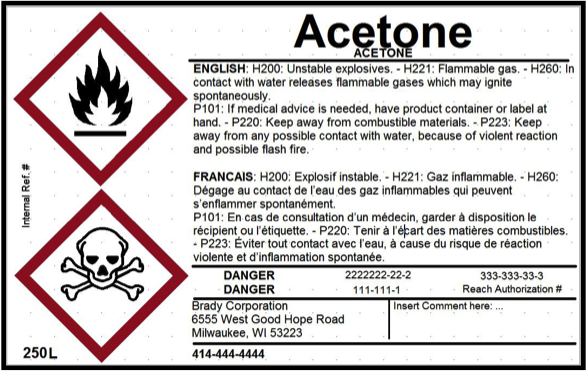Global Harmonized System (GHS)
Why the need?
The UN came together, realizing there was a global need to harmonize the communication of hazardous chemicals. Each country had some system, however with each looking and saying very different information, it was not easy to understand. The matters are complicated with many chemical manufacturers shipping product into multiple countries, and the local country possibly not even understanding the information on the label that comes in the door.
Country-by-country, around the globe, hazard classification and communication laws are similar in purpose but different enough to result in inconsistent hazard classification for similar products and dissimilar looking labels and SDS.
Harmonize and improve safety information and facilitate international trade through compatible classification methods, SDS, and labels.
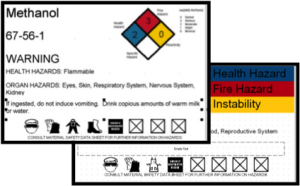
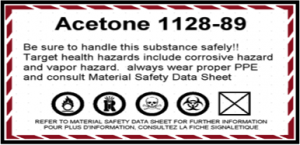
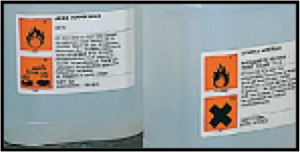
United Nations Conference on Environment and Development (1992) mandated a globally harmonized chemical classification and labeling system
Member States actively involved in creation:
- Unites States (OSHA representatives)
- Canada
- European Union
- Additional UN Members
GHS was formally adopted in 2002
- United Nations Committee of Experts on the Transport of Dangerous Goods
- iGlobally Harmonized System of Classification and Labeling of Chemicals
Goal of GHS
- Written by the UN, the goal of the GHS is to harmonize differing workplace hazard classification and labeling systems across the world
How GHS accomplishes that goal
- Harmonizes how hazardous substances and mixtures are classified
- Changes how hazard information is communicated (new pictograms and phrases)
- Streamlines the format of SDS and labels
What is GHS?
This showcases the different styles and types of hazardous chemical formats in various countries/regions. All these styles (Figure 1 -3 shown below) will now move to the GHS format (Figure 4 below) GHS Status in America.



All of these styles will now move to the GHS format (Shown below Figure 4) GHS Status in America
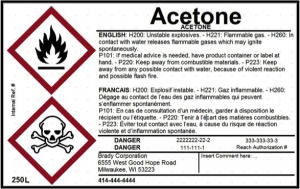
GHS Status in America
As discussed, in the U.S., it’s in final stages of development.
In Canada, Health Canada is responsible for overseeing adoption of GHS. Health Canada is currently reviewing GHS for incorporation into WHMIS. It’s further hoped and anticipated that the finalized regulation will be comparable to the US regulation. That is also a primary objective of what the UN and all participating countries are bent on accomplishing.
Mexico has come forward with a voluntary standard addressing GHS, NMXR019SCFI-2011. However, its pre-existing communication regulation, NOM018STPS-2000, remains in force. This results in dual labeling, and SDS’s Companies exporting and importing from nations implementing GHS are expected to comply with both. We understand the ANIQ national association has requested authorization from the Labor Secretary to develop an alternate procedure that can comply with both.
Finally, Brazil has implemented GHS for substances, following the course that the EU has taken, and has set a date of 1st of June 2015 for mixtures.
United States – adopted by OSHA as of May 2012
Canada – Reviewing for development:
- Health Canada Policy and Programme Services Office is national coordinator.
- Currently reviewing GHS for incorporation into WHMIS
- Estimated changes to WHMIS occurring in Spring 2013
Mexico – Voluntary standard proclaimed:
- The first NAFTA member to adopt the GHS as a basis for national health & safety regulations
- Proclaimed a new voluntary standard, NMX-R-019-SCFI-2011 (June 4, 2011).
- NOM-018-STPS-2000 remains in force.
- Dual labeling & SDS’s result
- Companies importing/ exporting products to and from countries in Europe, Asia & South America are required to comply with both NOM 018-STPS-2000 & GHS
- ANIQ (Associacion Nacional de la Industria Quimica) requested authorization from the Labor Secretariat for an alternate procedure to comply with NOM 2000 through the GHS NMX-R
Brazil – Implemented for substances:
- Pure substances (GHS classification, labeling & SDS) mandatory as of Feb 2011.
- Mixtures mandatory as of June 1, 2015
GHS Status in Europe & Around the Globe
Looking to Europe and the ROW, 27 EU countries + 3 candidate countries + 3 EEA countries. The previous European system, HSID, can no longer be used for Substances. While it can still be used for Mixtures, Manufacturers/ Producers/Distributors cannot apply both systems on labels.
Every SDS must display all required information in both systems until June, 1st – 2015.
Also, the original CLP regulation is based on the 2nd edition of the Purple Book. This past March, a second technical adaptation, regulation 286/2011, was published, so now CLP is fully based on the 3rd edition of the Purple Book.
This Technical Adaptation gives: New additional combined “H” phrases. Some exemptions in term of the usage of certain pictograms. The size of each pictogram is more specifically specified in regards of the size of label. No new things, but more precise.
27 EU Countries – Implemented under Regulation 1272/2008
- CLP is mandatory for 4,500 SUBSTANCES as of December 1, 2010
- CLP will be mandatory for all MIXTURES on June 1, 2015
- 2ND technical adaptation; Regulation 286/2011
Australia: Implemented (Dec. 2016 deadline); China: Implemented; Japan: Implemented
67 countries globally – at least partially implemented: See UN website.
OSHA’s Final Ruling on GHS
OSHA has updated its Hazard Communication Standard (HCS) to align with the United Nations’ Globally Harmonized System of Classification and Labeling of Chemicals (GHS).
Modifications will reduce costs and burdens while protecting employers and employees.
Modifications include:
- Revised criteria for classification of chemical hazards
- Revised and standardized labeling requirements
- A specified format for safety data sheets
- Requirements for employee training on labels and safety data sheets
Impact of GHS for U.S. Businesses
- 880,000 hazardous chemicals are currently used in the U.S.
- Hazard Communication affects 43 million American workers in over 5 million workplaces.
- GHS will prevent 500 injuries/illnesses and 43 deaths annually, equaling $250 million in reduced health and safety risks.
- Costs per year will total $201 million to comply with revisions tothe HCS.
- Future net benefits are estimated at $556 million per year.
Source: U.S. Dept. of Labor, OSHA, Directorate of Evaluation and Analysis Office of Regulatory Analysis, 2011.
